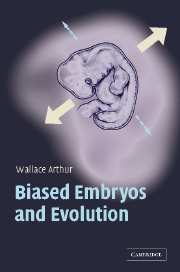Book contents
- Frontmatter
- Contents
- Preface
- Acknowledgements
- 1 The microscopic horse
- 2 What steers evolution?
- 3 Darwin: pluralism with a single core
- 4 How to build a body
- 5 A brief history of the last billion years
- 6 Preamble to the quiet revolution
- 7 The return of the organism
- 8 Possible creatures
- 9 The beginnings of bias
- 10 A deceptively simple question
- 11 Development's twin arrows
- 12 Action and reaction
- 13 Evolvability: organisms in bits
- 14 Back to the trees
- 15 Stripes and spots
- 16 Towards ‘the inclusive synthesis’
- 17 Social creatures
- Glossary
- References
- Index
13 - Evolvability: organisms in bits
Published online by Cambridge University Press: 02 December 2009
- Frontmatter
- Contents
- Preface
- Acknowledgements
- 1 The microscopic horse
- 2 What steers evolution?
- 3 Darwin: pluralism with a single core
- 4 How to build a body
- 5 A brief history of the last billion years
- 6 Preamble to the quiet revolution
- 7 The return of the organism
- 8 Possible creatures
- 9 The beginnings of bias
- 10 A deceptively simple question
- 11 Development's twin arrows
- 12 Action and reaction
- 13 Evolvability: organisms in bits
- 14 Back to the trees
- 15 Stripes and spots
- 16 Towards ‘the inclusive synthesis’
- 17 Social creatures
- Glossary
- References
- Index
Summary
The history of life is a mixture of stasis and change. We can recognize both of these in any particular interorganism comparison. Take, for example, two different species of vertebrates, such as ourselves and the horse. Stasis is apparent everywhere. We both have vertebrae, ribs, limb bones and so on. Furthermore, we both have limb bones that follow the same basic pattern – a single long bone in the upper limb but a pair of roughly parallel long bones in the lower limb. One way of describing these similarities, which we have both inherited from a common ancestor, is as a common body plan. Another way of describing them, which can be used more widely, is homology. We say, for example, that the femur bone in the horse's hind limb is homologous to the femur bone in our own leg. We'll get to grips with homology to a greater extent in the next chapter, but all we're really saying, in this example, is that the last common ancestor of humans and horses already possessed a femur, and that we both inherited modified versions of it.
But change is everywhere too. Not a single one of all our 200-plus bones is identical to its horse counterpart. Different sizes and shapes are not just the norm, they are universal. Compare what you like: skulls, limbs, ribcage and so on. The conclusion is the same. Evolution has left nothing untouched.
- Type
- Chapter
- Information
- Biased Embryos and Evolution , pp. 151 - 157Publisher: Cambridge University PressPrint publication year: 2004



